Your cart is currently empty!
Daniel Carter: A Dawning Light
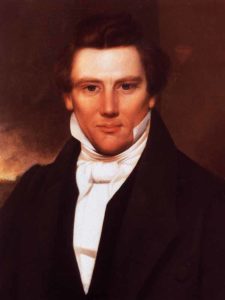 Let me tell you a story about how I came across Daniel Carter’s cantata on the Restoration: “A Dawning Light.”
Let me tell you a story about how I came across Daniel Carter’s cantata on the Restoration: “A Dawning Light.”
A few years ago when Daniel left the self-publishing business, he was practically giving away his music in one last fire sale. Not wanting his pieces to disappear unnoticed into the ether, I bought up copies of everything. And now, every time I’m ready to publish another piece, I’ll often hit up my personal library of currently unpublished Daniel Carter pieces to see what sounds good to go out next.
One of these was an early printing of his cantata — an earlier version of “A Dawning Light” — six original pieces on the Restoration and Joseph Smith’s First Vision. I think I had played through it once … thought it pretty, but laid it aside because it’s a full cantata … something that would take a lot of work to prepare.
Then late last October, I approached Daniel and said, “I have enough time to put out one more piece this year … something not Christmas,” and he gave me six options to choose from … all wonderful pieces. And one of them stood out … his cantata. I was already tired that year, after having put together hymns for the big hymnal submission, and then a busy second half of the year aggressively putting out pieces for Christmas and LDS Favorites for the 200th anniversary coming up. At first I was looking for something easy to take me through November so I could rest in December.
But that cantata stood out, especially with our own prophet, Pres. Nelson, talking up the 200th anniversary of Joseph Smith’s First Vision, and I realized … how could we NOT choose “A Dawning Light”? If I passed on it last October, then what good would it do to release it AFTER the celebration?
So, I said, “If you have enough energy, I think I have enough.” We went for it, for which Daniel seemed pleasantly surprised. And I passed up some other good pieces to do this (of which I hope to come back to later).
And it was a lot of work. I had wanted to be done by Dec. 1, but we were working on it all the way up to Christmas. Even after I had released the full cantata, we were still putting out individual pieces from the cantata through January and the first part of February.
Here’s one concern that we had. Back in the 80s and 90s, cantatas were a big thing in our church. Choirs appreciated the challenge, and congregations enjoyed the narrations that went with it. But these days, times have changed. Wards are less willing to pay $4.50 a copy for the whole choir, and musical sacrament meetings are generally frowned upon these days. So, we decided to offer different options to meet the needs of budgets and bishopric approvals.
The full cantata book (with narration) is available for $4.50. Smaller choral booklets (without narration) are available for $2 a copy. These choral booklets are synced with the full cantata book with rehearsal numbers and consistently numbered titles. We also have bulk pricing for download options which provide both the full cantata book and the choral booklets — $30 total for up to 30 copies, and $50 for larger choirs.
We also decided to offer all six pieces individually for wards that won’t allow more than one piece at a time. You can explore all available options here.
Before diving into the pieces themselves, Daniel and I had two other experiences worth sharing.
One problem was with the sixth piece in the original cantata, “The Lost Lamb.” Daniel no longer owns the copyright for that piece, so we were unable to use it this time. It was a shame, as the first time I read through it, it left me in tears. Its tenderness and unique point of view from the “lost lamb” is very touching, and it’s a piece still relatively unknown. Jackman Music sells a choral version here. It’s a highly recommended arrangement, though I’m still partial to the solo version that is now no longer available — anywhere.
Daniel was able to take an older piece and add other words with a similar message, and thus “Love and Hope That Heal” was born. He gave me one verse, and I said, “It needs another,” and he came back with a second verse the next day … better than the first.
Also, Daniel had a desire to improve the cantata. I mentioned that the singing range in a couple of the pieces were kind of wide — both low and high. About a week later, he submitted adjustments in an attempt to simplify the music. In a couple of places, I think the changes worked better, but in others, it felt like something got lost in the changes … it was something of lesser quality — something bland, and I was sad to have triggered the adjustments. I tried to make up for it by suggesting some simple adjustments in an attempt to restore some of the original material. And a couple of days later he came up with a great idea: Put everything back in the beginning and have the bass/altos sing the low parts of the melody, and then the tenors/sopranos take the higher parts — still leaving the option for everyone to sing the entire melody if they are able.
And Daniel kept some of his new changes — the ones that seemed to work better, resulting in something of greater quality in the end.
Through this, I learned a valuable lesson — other music publishers work hard to dumb down the music in an attempt to make it easier for the performers to sing, but is that what the composers of great songs did? When Handel penned his “Messiah,” did he say, “No, I don’t think these sopranos can hit a high A, so I better write something lower”? I didn’t want to do this to Daniel, so I let the slightly harder version get published so all could enjoy the richer melodies. Note: I will offer specific recommendations for performance down below when we hit the individual pieces.
I feel like this is a powerful and performable cantata that can positively enhance a sacrament meeting or fireside in commemoration of the 200th anniversary of Joseph Smith’s First Vision.
Before hitting the individual pieces, here are words from the composer, himself:
“A Dawning Light” was composed to help fill a need for more music about the Restoration and First Vision of Joseph Smith. After I composed the title choral work and performed it with my ward choir, I realized that we needed much more music on this subject. A few months later in early 1990, I had a whole Sunday afternoon and started thinking about how best to begin filling the need I saw for music about the Restoration and the First Vision. My mind started racing and I sat at the piano penning words and ideas, and creating musical themes. It didn’t take long till the entire vision of “A Dawning Light” cantata was in my head. It was a strange and exciting experience to have words and music flowing so quickly that I could hardly write it all out. (In those days we notated everything by hand with manuscript paper and pencil. Something I still do.)
By late evening I had the entire cantata done. I put it away for a week or so, as I normally do so that I could look at it with a clearer perspective. After editing, revising and refining, my hand-drawn manuscripts were taken to the printer where I had 20 copies made and bound. I didn’t know where or when it would be performed, but I had 20 copies on hand, prepared for the opportunity.
About a year later our stake produced a concert fireside where they performed “A Dawning Light” along with other music. It was a good enough success that the cantata was included in various other fireside concerts for the next 10 years.
Now, 30 years later, the cantata had never been published until now. And 30 years has given me a little more insight and skill to go back through this cantata and refine a few more things, which I think is to everyone’s advantage.
I’m very happy for the opportunity to have this little cantata published at last. And I’m very thankful to all of you will breathe life into my little dots and squiggles.
—Daniel Carter
Here is a simulated performance of the entire cantata — you may listen as you read about performance suggestions.
And here is where you can find more information on the buying options for the whole cantata or its individual pieces.
Now, let’s take a look at the six pieces …
1) A Dawning Light
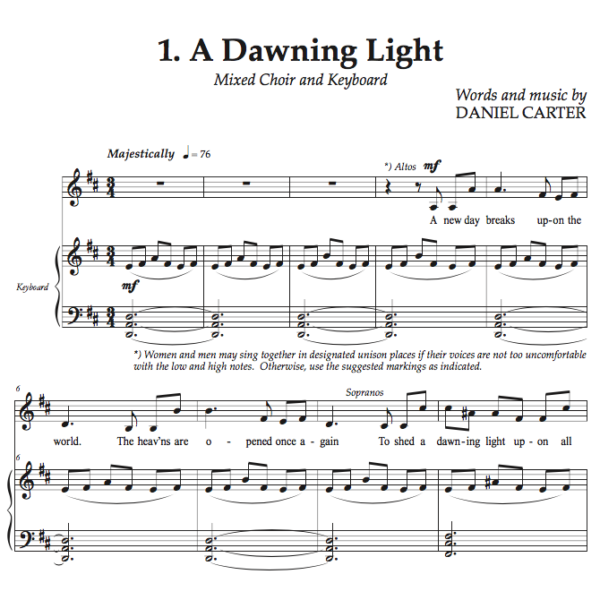
This title piece, as Daniel mentioned above, was first composed as a standalone song. The melody starts low and slowly rises by step to a high E before coming down again. If at all possible, you should have the choir (first women, then men) sing the entire melody in unison. That low A may be a bit low for sopranos and tenors, but altos and basses can cover. Also, the high E may be high for basses and altos, but with good breath support and open throats, most men and women should be able to high those high notes without resorting to falsetto/head voice.
If you so determine, it’s perfectly fine to perform as written — Altos – Sopranos – Bass – Tenors — thus letting everyone have separate turns on the melody. This would be preferred over falsetto.
Section B should be sung as a prayer. You can slow down a bit for a more reverent feel.
Section C begins an imitation sequence (from the main melody) that begins at medium level and builds all the way to the end … celebrating the new dawning light. Always crescendo and build during this section.
2) If Any of You Lack Wisdom
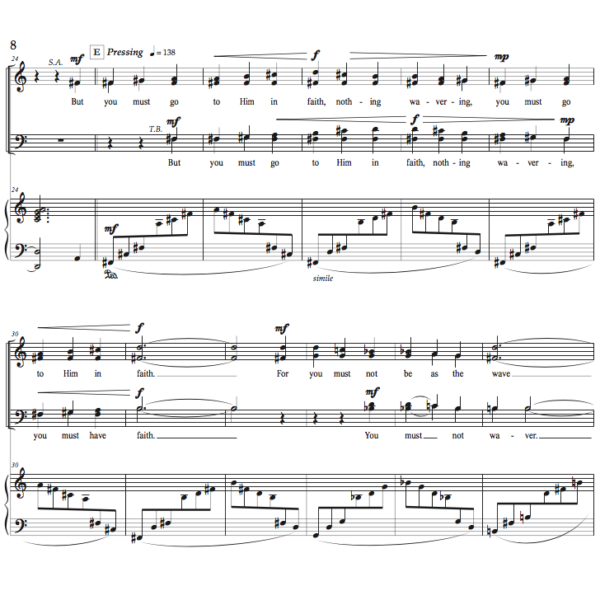
The solo can be sung by a mezzo soprano or a baritone. The melody is somewhat modal … going in and out of D major/minor. Overall all, this piece can go at a nice medium pace.
Section E should be sung flowingly and smooth — at a slightly faster tempo. The accompaniment resembles rolling water as if trying to drown those who happen to be riding on it.
But Section F overcomes — faith is the way to survive — you can find answers by asking God. This point is driven home in a canon-like repetition — a section that’ll get stuck in your head if you’re not careful.
Make sure to stop briefly before the women sing a little echo at the end — one last reminder — ask Him in faith.
3) The Light of Love
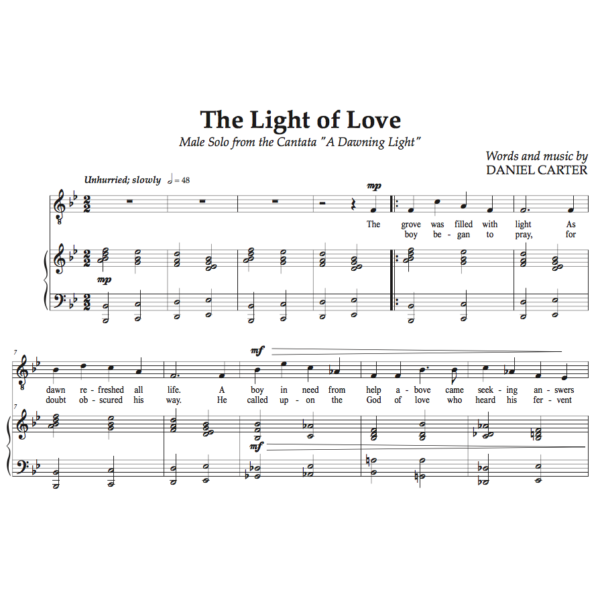
Of all the sections, this is the one that Daniel revised the most — placing it in a new key and fixing the melody in several places. It is best sung at a walking tempo. A woman can sing this, but it works better in the lower octave.
This song explores the story of the First Vision. It contains a lot of sustained notes, so it’s best to always use plenty of breath and sing legato throughout. The pitches may seem a challenge at first — as several notes are not played by the piano, but I find that after a couple of run-throughs, the melody quickly becomes locked in. It may help to sing a couple of times along with a recording and then it should become easier.
4) To Those with Pure Intent
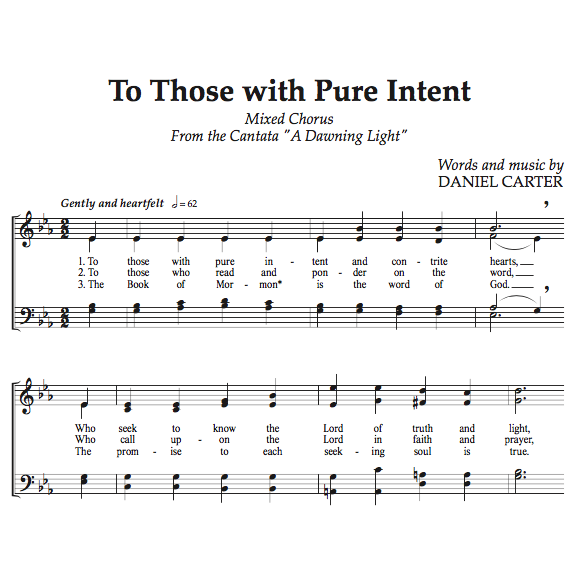
This short hymn explores the concept of Pure Intent, in which one can learn the truth of the scriptures. You can sing this like most any other 4-part hymn — with or without accompaniment.
You can also obtain it for free download here.
A funny story … if you have a music theory background, you may notice the parallel fifths in the last line between the bass and tenors. Usually I hate parallel fifths (movie music is replete with them — and they are rare in our Hymnal), but sometimes when intentional, they work, as they do here. It provides a unique sound. When I saw them … I said to Daniel, “I see those parallel fifths, and I like them — I’m not going to ask you to change them.” And he answered, “Yes … I put those there on purpose.” He then talked about how when it was published in a Church magazine, they tried to get him to change the parallel fifths, but he talked them into keeping them in there.
So, when you perform — enjoy those fifths, men!
5) The Priesthood Now Is Restored
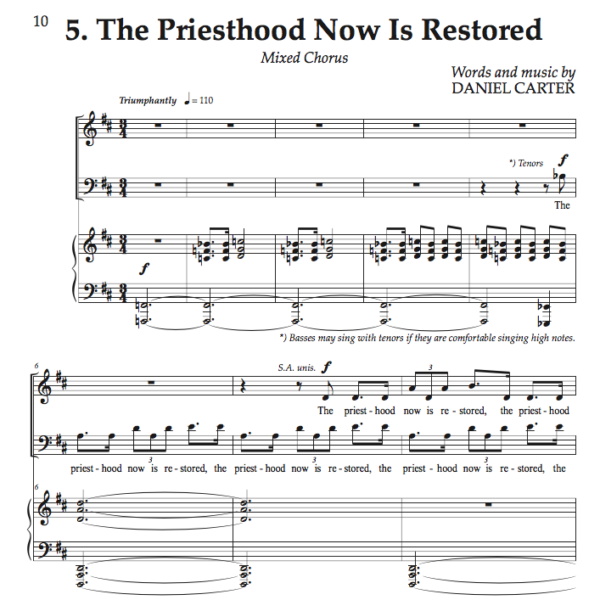
This quick piece is guaranteed to brighten up any service — a great song for celebrating the restoration of the priesthood. It goes by very fast, but the tunes can get stuck in your head easily.
The first part is like a trumpet fanfare, except for piano and voices. In fact, if you’re using organ for this piece, make sure to include plenty of reeds, the high fraction stops, and a 32′ stop for pedal.
You may notice that the men sing pretty high during this first part. Daniel and I seriously considered lowering everything down a whole step to make it easier to sing, but then the song seemed to lose its brightness. The sound of men singing high with strength is exactly the sound that is needed. Since it goes by so fast, it should not be too difficult for men to sing — just remember plenty of breath support. If basses can’t handle it, then let tenors take over for the first part, as written in the score.
Rehearsal H lets the singers slow down a bit, but still with strong praising. These chords may sound different at first, but every line is easily doable. Once the singers get through the initial “what?” they should quickly get used to the sound and be able to find their notes with ease. During this part, the piano/organ is playing the same notes, and thus provides plenty of support. To me, this section sounds like a typical Philip Glass chord progression, but I think that’s just me.
The “trumpets” come back at rehearsal letter I, just like as the first. Then there are a few more Philip Glass chords, and then the tenors get to shine with one last trumpet call.
6) Love and Hope That Heal
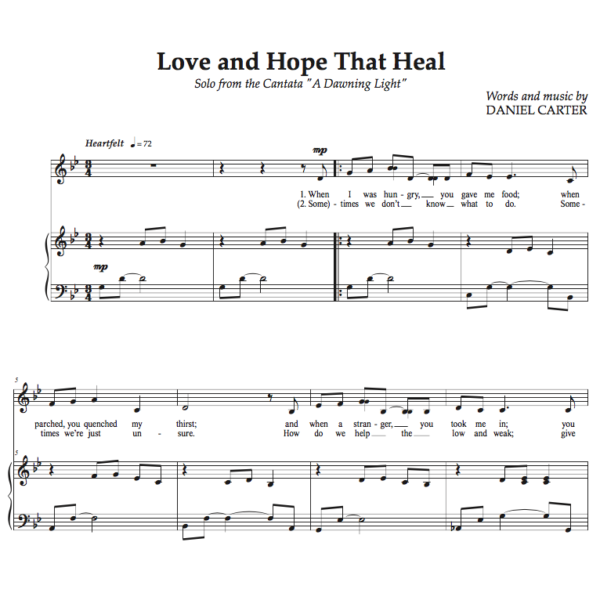
The cantata almost ends with this new piece exploring the gospel of peace and love, which is ultimately the main message of Christ’s Church newly restored. I say “almost” ends because the script calls for a repeat of the title song after this one.
“Love and Hope” is an older tune published in a Church magazine, but these lyrics were just written in the last few months, specifically for this cantata. It is also a good standalone song — making no reference to Joseph Smith, it is all about Jesus’s teachings in Matthew 25:40 — “Inasmuch as ye have done it unto one of the least of these my brethren, ye have done it unto me.”
The range in this solo is singable for most anyone. It’s best to just let the words guide you in the performance, and you will naturally sing the right dynamics and style.
So, there you go … six pieces in one cantata. I hope you will consider including this in a sacrament meeting or fireside commemorating the Restoration of the Priesthood, as soon as the current health crisis allows us to go back to church. Again, make sure to check out the different buying options and performance options here.
by
Tags:

Leave a Reply